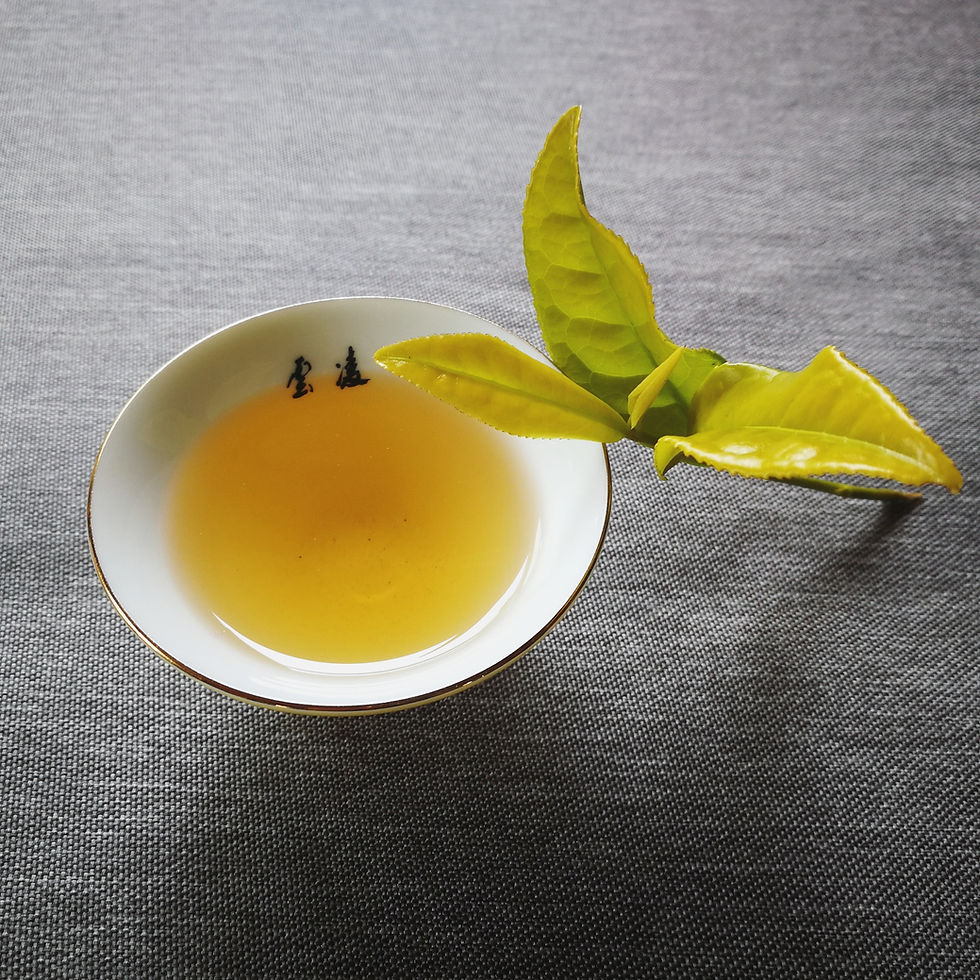Blog 125: Wuyi Oolong (Yancha): The Assessment of “Maocha/毛茶” (Part II)
- Valley Brook Tea

- Jun 1, 2019
- 3 min read
Maocha/毛茶 is half-processed Wuyi oolong (Yancha) leaves (before the roasting process). Although Maocha is not yet a tea product, it’s crucial in the entire Wuyi oolong tea-making process. In our last tea blog, we introduced why “Maocha assessment” is important and how our experienced tea makers assess the quality of dry Maocha leaves. If you haven’t read it, we highly recommend you check it out before continuing with this blog. (Click here for Blog 124)

Today, let’s continue this topic and discuss how our tea makers assess the tastes and the aromas of a Maocha.
The tastes and the aromas are the most iconic features of a tea, and they’re also the most critical of a Maocha assessment.
The assessment of a Maocha’s tastes mainly focus on the clarity, the thickness, the dryness/bitterness, and “in-tea-soup aroma”/落水香.

The Clarity
The clarity of a Maocha’s taste is decided by the tea-making, not the quality of fresh leaves. Maocha leaves processed with impeccable tea-making has a very distinct and fresh taste, and it should be free of foreign flavors such as the gassy taste. Because oolong tea is half-fermented, any under-fermentation or over-fermentation would have a direct impact on the clarity of Maocha leaves.
Under-fermented Maocha leaves carry a gassy and earthy taste, and they’re easily getting “damped” in storage. Therefore, under-fermented leaves need extra care during the roasting process. Over-fermented Maocha leaves usually taste more like black tea leaves. However, in oolong tea, this “black-tea-like” taste is quite depressing and blurry.

The “Thickness”
The “thickness” of a Maocha depends on the weather, the tea field climate, and the freshness of leaves at the time of the harvest.
There are many reasons why a Maocha might taste too “thin”. For instance, if leaves are too old/broad at the time of the harvest, too much water loss in the “shaking process” (see Blog 12 for more), or rolled too lightly, Maocha will taste very “thin”.

The Dryness/Bitterness
The “thickness” and the “dryness/bitterness” of a Maocha represent two opposite sides.
When leaves are too old at the time of the harvest, they’ll taste “too light”. But if leaves are too young at the harvest, they might taste dry/bitter.

Besides the tastes, the aromas of a Maocha also need to be throughly assessed.
In general, tea makers are looking for very distinct and clear fragrances in a Maocha. These nice fragrances often appear on the lid of the Gaiwan and the walls of the tea cup.
If a Maocha’s aromas are faint or hard to distinguish, there’s a high possibility that it’ll have impure aromas after the roast.
Also, Maocha with smells like grassy, fermenting, sour and scorched are considered as inferior.
Finally, the tea soup color can be an indication of Maocha quality, too. Since Maocha leaves are not yet roasted, they produce a charming light yellow color when infused. Colors like “red” or “orangish red” indicate that Maocha leaves are either over-fermented or burned. A Maocha with red and orangish red tea soup colors is not preferred.
(We’ll continue this topic in our next blog…)
We hope you enjoyed today’s blog. As always, if you have questions or suggestions, please leave a comment, tweet us @valleybrooktea or email the author directly at zhang@valleybrooktea.com. Please also follow us on Instagram @valleybrooktea and join our mail list to get our daily tea updates and our latest promotions!
This is a Valley Brook Tea original blog. All rights reserved.




Kaiser OTC benefits provide members with discounts on over-the-counter medications, vitamins, and health essentials, promoting better health management and cost-effective wellness solutions.
Obituaries near me help you find recent death notices, providing information about funeral services, memorials, and tributes for loved ones in your area.
is traveluro legit? Many users have had mixed experiences with the platform, so it's important to read reviews and verify deals before booking.